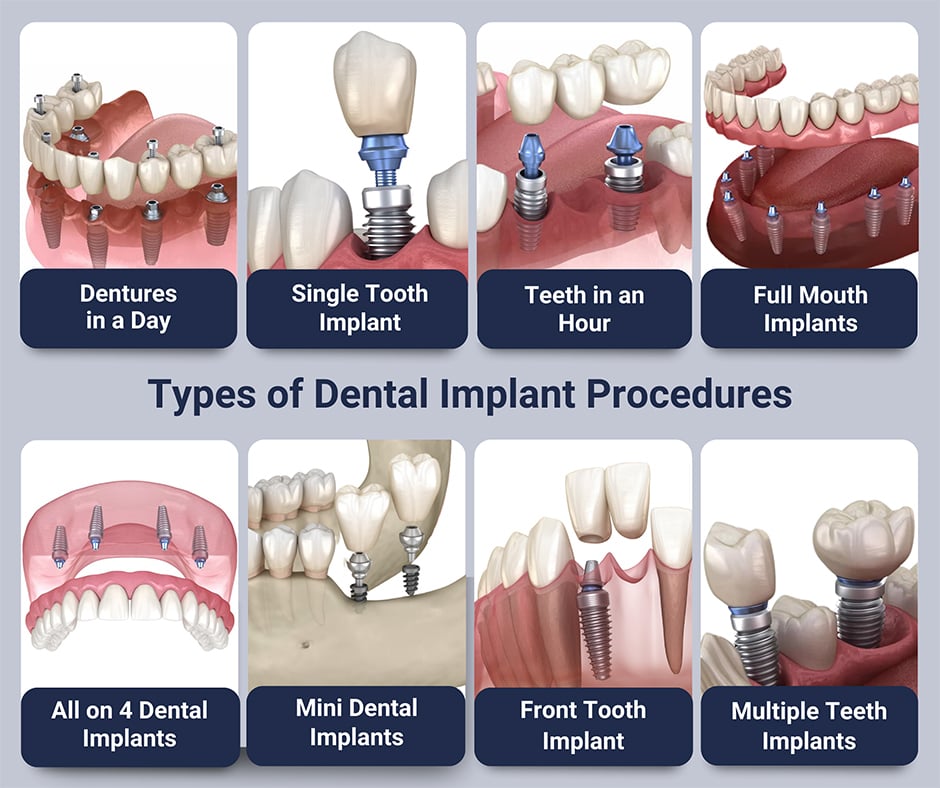Not known Details About Dental Implants
Not known Details About Dental Implants
Blog Article
Everything about Dental Implants
Table of ContentsDental Implants Fundamentals ExplainedThe Best Guide To Dental ImplantsTop Guidelines Of Dental ImplantsThe 30-Second Trick For Dental Implants
are clinical devices operatively implanted into the jaw to bring back an individual's capability to chew or their appearance. They offer support for synthetic (phony) teeth, such as crowns, bridges, or dentures. When a tooth is lost as a result of injury or condition, a person can experience complications such as rapid bone loss, malfunctioning speech, or adjustments to chewing patterns that cause discomfort.
Structure of The Oral Implant System choosing dental implants, speak to your oral supplier concerning the prospective advantages and dangers, and whether you are a prospect for the treatment. Points to take into consideration: Your general health is a vital aspect in figuring out whether you are a great prospect for dental implants, the length of time it will certainly take to recover, and the length of time the implant might remain in location.
Smoking might influence the recovery process and decrease the long-term success of the implant. The recovery process for the dental implant body might take several months or longer, during which time you commonly have a momentary joint instead of the tooth. the oral implant procedure: Meticulously adhere to the dental hygiene directions provided to you by your oral supplier.
An Unbiased View of Dental Implants
Implant failing can cause the demand for one more procedure to deal with or replace the dental implant system. Recovers the ability to eat Brings back cosmetic appearance Aids maintain the jawbone from shrinking as a result of bone loss Maintains the health of the surrounding bone and periodontals Aids keep nearby (nearby) teeth stable Improves high quality of life Damages to surrounding all-natural teeth throughout dental implant positioning Injury to the surrounding cells during surgery, such as sinus perforation Injury throughout surgery (for example, crack of surrounding jawbone) Inadequate feature, such as seeming like the teeth do not bite with each other generally A sensation that the tooth is loose or turning in position resulting from a joint screw loosening up Implant body failure (looseness of the implant body) as a result of systemic infection, which may be most likely in patients with unchecked diabetics issues due to neighborhood infection in bone and gums sustaining the implant body due to delayed useful content recovery, which may be more likely in clients who smoke Problem cleansing the gum tissues around the dental implant, causing inadequate oral health Untreated periodontal disease Post-surgical tingling due to nerve impingement or damage Always notify wellness care companies and imaging professionals that you have dental implants before any type of magnetic vibration imaging (MRI) or x-ray procedures.
FDA is not aware of any type of adverse events reported for MRI or x-ray procedures with oral implants. Dental implants systems are usually made from products that comply with global agreement criteria of the International Organization for Standardization (ISO) or ASTM International. These criteria have details of what makes a risk-free material.
Various other products such as gold alloys, cobalt-based alloys, titanium alloys, or ceramic materials are often used. The safety accounts of these products are popular. Dental dental implant systems are examined according to global agreement standards. Biocompatibility testing, to reveal that physical call with the gadget does not trigger issues like irritation or allergic reaction, becomes part of the evaluation that aids make sure the materials in the oral implant system are risk-free and do not create adverse results when implanted in individuals.

Indicators on Dental Implants You Should Know
Some people are not eligible for oral implant surgery. It is for dental surgeons to run on individuals with: acute illnessuncontrollable metabolic diseasebone or soft tissue condition or infectionIf these concerns are resolved, an individual can have the surgical treatment. Dental Implants. In, dental doctors refrain from running on people with: If individuals with any of the above undergo oral implant surgical treatment, there is a greater risk of the implant falling short
Some people have a jawbone problem that stops adequate bone for a dental implant from establishing. In such situations, a cosmetic surgeon may need to do a ridge adjustment. This involves web link raising the gum tissue to go to this site expose the area of deformed bone. The specialist will then utilize a bone or bone substitute to fix and develop the location.
Oral dental implant surgical treatment is an individualized procedure. It's not the same for everybody. But the complying with offers a basic summary of what you can expect your dental practitioner, dental surgeon, periodontist or prosthodontist to do: Put the dental implant operatively. Offer you time to recover. Attach the message and final crown, bridge or denture.
Next off, your specialist will very carefully place the oral implant right into your jaw. Lastly, your surgeon will rearrange your gums and shut the cut with stitches. If your dental implant is near the front of your mouth, your dental practitioner will certainly make a short-term tooth for you to put on till you recover. That means, you won't have a space in your smile while you recuperate.
The Greatest Guide To Dental Implants
During the healing phase, your jawbone ought to fuse to the oral implant. This procedure can take anywhere from three to 9 months.
When your dental implant heals, your dental professional can attach the abutment (small connector post) and your final repair (crown, bridge or denture). This usually takes concerning one hour to complete and might call for a second minor surgical treatment. You should not feel any type of discomfort during your oral implant treatment since your company will make use of drug to numb your gums.
Report this page